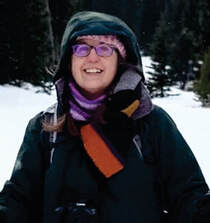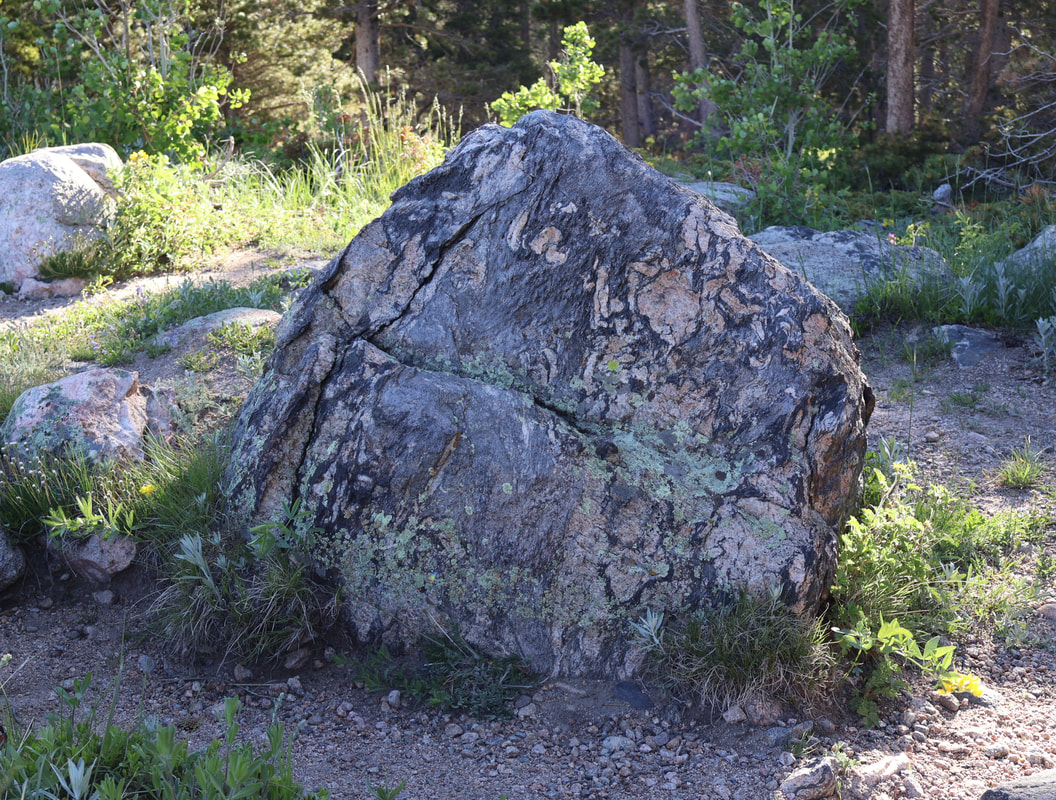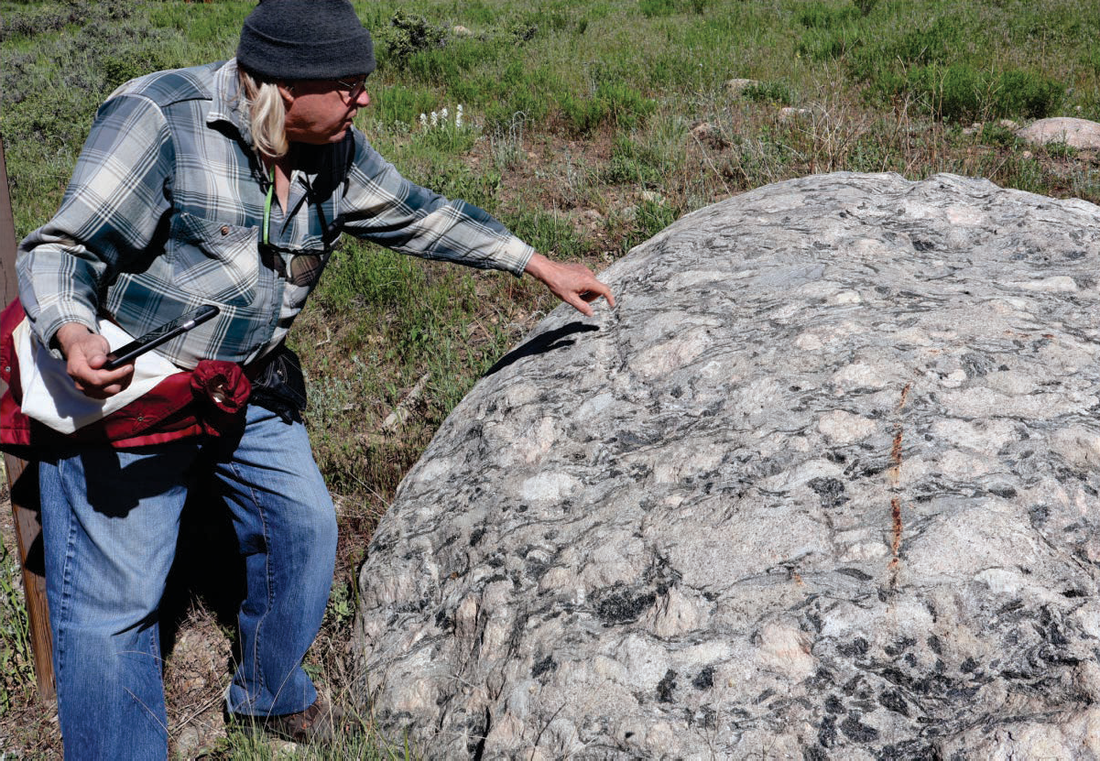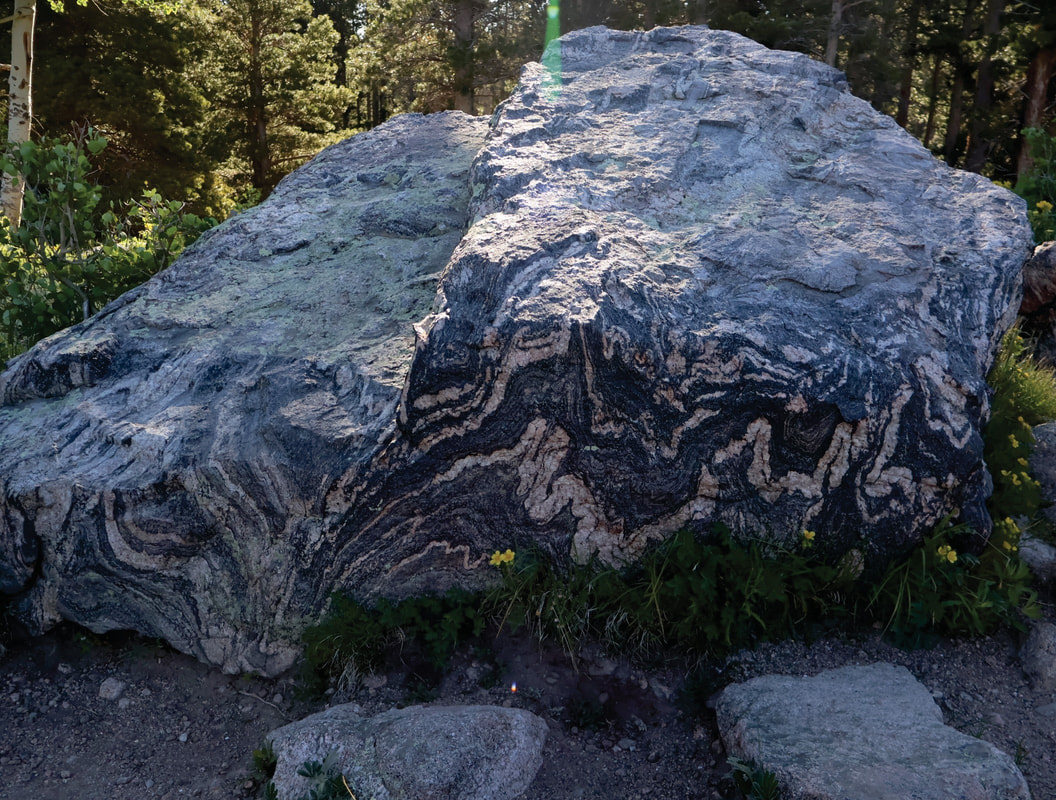|
story, photos and video by Barb Boyer Buck Driving up to Estes Park from the Front Range, you travel on roads that were cut through dense layers of basement rock, pushed up from the ground in what looks like a violent fashion. The sight humbles me; I feel quite small, even though this happened millions of years ago. I have to remind myself these rocks are stable enough to support roads that carry four million people to Rocky Mountain National Park each year. The majestic Rocky Mountains that come into view as you dip down into Estes Park look like timeless unchanging sentinels of this mountain valley. But in reality, they are constantly evolving. “There are about seven different plates floating around on the skin of the mantel of the Earth,“ explained Roy Dearen, retired geophysicist and environmental geologist who now lives in Estes Park. “Kind of like a skin on an onion, they are thin and less dense than the mantel below them so they float at a very slow speed, about the speed of your fingernails growing. The Pacific plate and the North American plate are pushing against each other in opposite directions. That's how the ancestral Rockies were formed. The tops of these mountains, at one time, were at least 20,000 feet above sea level.” Roy was born and grew up in Texas; he moved to Colorado in 1975. In 1981, he earned a degree in geology from the University of Colorado at Boulder. He has worked for American Copper & Nickel as a geophysicist, as a seismic interpreter for oil and gas exploration and supervised clean-up operations at the Rocky Flats Nuclear Weapons Plant in the mid-1990s. But I suspect it's his experience as a third and fifth grade teacher at Lyons Elementary School that makes him such a great person to interview on this subject. He makes geology accessible and easy to understand. Roy was kind enough to meet me to discuss the rocks of the Rocky Mountains, specifically those in Rocky Mountain National Park. He shared a geology presentation he gives while conducting tours of Rocky. At a small pull-out in Horseshoe Park just before Sheep Lakes, Roy encourages everyone he takes on this tour to turn toward where Longs Peak sits. Then, he explains the geologic history of the Park, from 90 million years ago until the present. Words are not adequate to put this information into perspective so in the video below, the entire presentation is recreated. But the only way to really experience the unique geology of Rocky is in person. The rocks of the Rocky Mountains are products of erosion and displacement, pulled inexorably downward by gravity. On a tour of the Bear Lake Corridor early this week, Roy showed me some of the more unique rock formations of the area. Of particular interest was a stretched pebble conglomerate: an interesting boulder that collected large pebbles as it was formed, the pressure of the metamorphic process elongating the pebbles in a distinct direction. We were also on the hunt for gneiss (pronounced “nice”). These ancient rocks were formed deep in the Earth, from granite heated to the consistency of toothpaste and squeezed through the cracks in the harder schist layers. Retreating glaciers after the last ice age tumbled the rocks, rounding them in the same process a rock- tumbling machine does. In the large, peaceful parks within Rocky, these round rocks look like they had been placed there by a landscape designer. But everything has a natural cause – and effect. Glaciers created the lateral moraines that border Moraine Park, Horseshoe Park, Upper Beaver Meadows and the Kawuneeche Valley, to name some of the biggest examples. But these shrinking glaciers (there are still a few in Rocky) are like fingers raking wet sand, creating many of the gullies and narrow canyons in these mountains over 10s of millions of years. These small canyons provide shelter for many species of animals and create microcosms of waterfalls and foliage not found in the blaring sun of Park’s mountaintops. Rocky Mountain National Park's majesty, breathtaking rock formations and views will look quite different in the future as time marches on. What will glaciers leave in their wake during the next ice age, perhaps 10 thousand years from now? We can count ourselves incredibly lucky to be living in this particular time of the geologic history of Rocky.  Barb Boyer Buck is the managing editor of HIKE ROCKY magazine. She is a professional journalist, photographer, editor and playwright. In 2014 and 2015, she wrote and directed two original plays about Estes Park and Rocky Mountain National Park, to honor the Park’s 100th anniversary. Barb lives in Estes Park with her cat, Percy. This piece of original content was made possible by Affinity Massage and Wellness, The Country Market of Estes Park and Images of Rocky Mountain National Park.
0 Comments
Leave a Reply. |
Categories
All
|
© Copyright 2025 Barefoot Publications, All Rights Reserved






